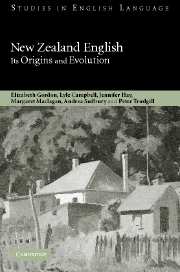Book contents
- Frontmatter
- Contents
- List of figures
- List of tables
- Acknowledgements
- List of abbreviations
- Symbols used
- 1 Introduction
- 2 Overview and background
- 3 The historical background
- 4 Previous attempts to explain the origins of New Zealand English
- 5 Methodology
- 6 The variables of early New Zealand English
- 7 The origins of New Zealand English: reflections from the ONZE data
- 8 Implications for language change
- Appendix 1 Mobile Unit speakers
- Appendix 2 The historical background of some settlements visited by the Mobile Unit
- Appendix 3 Maps
- Appendix 4 Seven Mobile Unit speakers born outside New Zealand
- Appendix 5 Acoustic vowel charts for the ten speakers included in the acoustic analysis
- Appendix 6 Speaker indexes for quantified variables, together with relevant social information
- References
- Index
- References
Appendix 2 - The historical background of some settlements visited by the Mobile Unit
Published online by Cambridge University Press: 22 September 2009
- Frontmatter
- Contents
- List of figures
- List of tables
- Acknowledgements
- List of abbreviations
- Symbols used
- 1 Introduction
- 2 Overview and background
- 3 The historical background
- 4 Previous attempts to explain the origins of New Zealand English
- 5 Methodology
- 6 The variables of early New Zealand English
- 7 The origins of New Zealand English: reflections from the ONZE data
- 8 Implications for language change
- Appendix 1 Mobile Unit speakers
- Appendix 2 The historical background of some settlements visited by the Mobile Unit
- Appendix 3 Maps
- Appendix 4 Seven Mobile Unit speakers born outside New Zealand
- Appendix 5 Acoustic vowel charts for the ten speakers included in the acoustic analysis
- Appendix 6 Speaker indexes for quantified variables, together with relevant social information
- References
- Index
- References
Summary
In this appendix, we describe the historical background of some of the towns visited by the Mobile Unit. We do this to demonstrate the amount of variation within settlements and among settlement types in different parts of the country and to provide a context for the Mobile Unit speakers, whose speech is analysed in this book. We make use of various historical sources including census reports.
1 North Island
The North Island settlements chosen are Wanganui, representing an early settlement and part of the New Zealand Company efforts; the Waikato towns, established in connection with military occupation at the time of the New Zealand Wars; and Thames, which began as a goldmining town.
1.1 Wanganui
Wanganui, 150 miles north of Wellington at the mouth of the Wanganui River, was founded in 1841, one year after New Zealand became a British colony, as an off-shoot of the New Zealand Company's first settlement in Wellington. Its development into a market town with a port depended to a large extent on the growth of the economy of the wider region. The district had a considerable Maori population, and trade in potatoes, fruit, wheat, and pigs for Wellington gave the settlement its early start – a trade described in several of the Mobile Unit interviews. Up to 1846, the settlement had about 200 people, with hotels, small schools in private homes, and an Anglican church (Smart and Bates 1972: 81).
- Type
- Chapter
- Information
- New Zealand EnglishIts Origins and Evolution, pp. 296 - 309Publisher: Cambridge University PressPrint publication year: 2004



